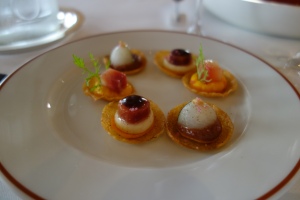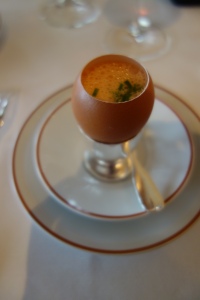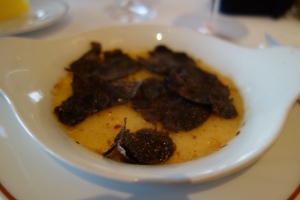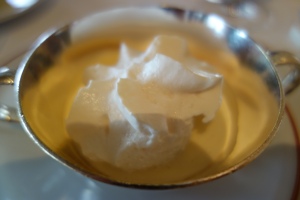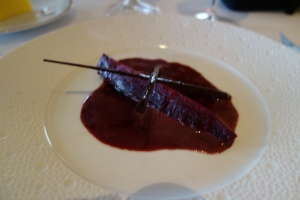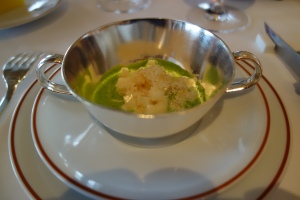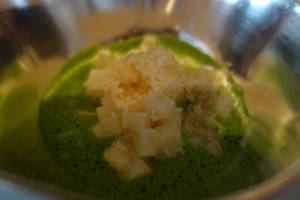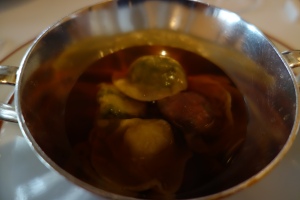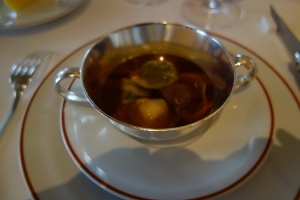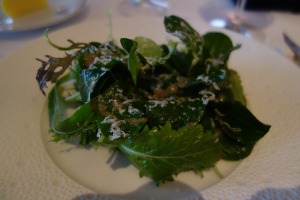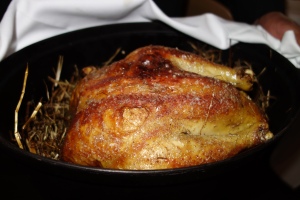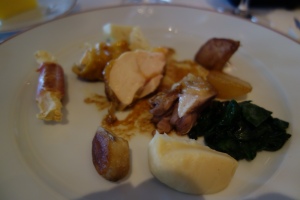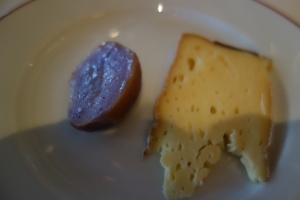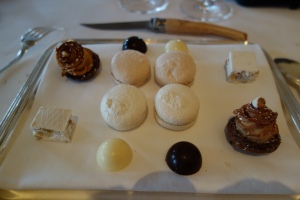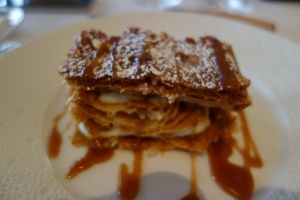- Address: 84 Rue de Varenne, 75007 Paris, France
- Phone: +33 1 47 05 09 06
- Price (after tax + tip, excl. drinks): $190
- Courses: (9 main/13 total) 3 amuse / 8 savory / 1 dessert / 1 mignardises
- Price/Main Course: $21
- Rating: 20/20
- Value: 4/5
- Dining Time: 140 minutes
- Time/Course (total): 10.5 minutes
- Chef: Alain Passard (ex. L’Archestrate (Alain Senderens) which is now the location of l’Arpege, Le Duc d’Enghien)
- Style: Vegetable-focused / Minimalist
- Michelin Stars: 3
- Favorite Dishes: Celerisotto, Millefeuille, Cevennes Onion-Truffle Gratin
- Notable: Considered the best vegetable restaurant in the world. Passard has three specialty vegetable farms throughout France, each with their own climate and soil conditions.
In January 2001, Alain Passard made the headlines, having declared that ‘my menu will be entirely and exclusively dedicated to vegetables’. His decision was motivated mainly by personal choice, but in part by health concerns too (mad cow disease had reached France the previous year). The chef, having spent thirty years establishing himself as a maître rôtisseur, admitted that he ‘didn’t take any pleasure any more in eating meat’ and that ‘blood and animal flesh’ had stopped being a source of inspiration. The situation became so serious that Passard spent an entire year away from his kitchen, only setting foot in the restaurant to eat. ‘I no longer wanted to be in a daily relationship with the corpse of an animal. I had a moment when I took a roast out into the dining room and the reality struck me that every day I was struggling to have a creative relationship with a corpse, a dead animal. And I could feel inside me the weight and the sadness of the cuisine animale.’
Vegetables were his salvation. He needed new motivation and found it by replacing the raw materials with which he moiled, ‘like an artist who works in watercolours and turns his hand to oils or a sculptor in wood who changes to bronze’. The colours, flavours and perfumes of greens, herbs and flowers appealed to and stimulated him; more to the point, they changed his life. ‘All the terrible nervousness and bad temper that are so much part of the burden of being a chef were gone with the old cooking. I entered into a new relation to my art, but also to my life. And the lightness of what I was doing began to enter my body and my entire existence and it entered into the existence of the kitchen. It was like a light that I saw and a door that I walked through’.
…
“The restaurant itself resides near the prime minister’s offices and government ministries, on a quiet street, opposite the Musée Rodin. Without, it is non-descript and unadorned save some flowery script that spells out l’Arpège, but within, the dining room is warm and comfortable. Rich browns and earthy oranges dominate; pear wood panels line the interior; and a dog-eared, burgundy carpet covers the floor. Music is Passard’s second love and the melodious insinuation suggested in the restaurant’s title is maintained by the motif inside: handmade Lalique pâtes de verre, inspired by the carriages of the Orient Express and inset along the far wall, depict Pan playing the flute whilst frolicking with two naked nymphs (images mimicked on menu covers); an abstract split cello sculpture by Arman sits in one corner; a coarsely-carved wooden guitar grows out the serving station; and, upon Bernard Pictet windows, etched waves ripple. This undulating design is also incorporated into Jean-Christophe Plantrou’s peau de poirier panelling and Massacar ebony furniture pieces. Rich, red leather upholstered chrome seats andchariots as well as the various bucolic bibelots such as large desiccated gourds or little twig bundles that rest upon tables, play on art déco principles. The only presence on the room’s walls is the nineteen-thirties/forties portrait of Louise Passard, which watches over the ‘chef’s chair’. White linen tabletops are dressed with bright red cover plates, Bernaudaud crockery, Christofle cutlery and customised glassware inscribed ‘Fabrique pour Alain Passard’.”
ChuckEats –
“As I’ve written before, L’Arpege can be hit or miss. At its best, it is the pinnacle of modern fine dining – excellent ingredients whose natural qualities are emphasized to unbelievable heights. There is a balance, precision, and purity of flavor – not new taste combinations or culinary technique from the future. When it is performing at this level, it is a contemplative and ephemeral cuisine, like poetry.”
There is also a comic book published in 2013 about Alain Passard’s cooking: In The Kitchen with Alain Passard, which I enjoyed very much. Here are some choice words from Alain Passard:
“I want to make people talk about carrots the way they talk about grand crus. Terroir is extremely important for me. We did trials. I asked the guys to plant seeds in three terroirs. The same turnip seeds, for a mauve-and-white turnip. The idea is to see how the produce reacts to different terroirs. In the Sarthe you have sandy soil. In the Manche it’s alluvial soil, and in the Eure it’s clay. Rainfall patterns are different. To see where the plant becomes tastiest and most elegant. The crew sends me turnips from the three terroirs after a few months. I evaluate the color, the look, the smell, the mouthfeel. I cut each one open, observe the texture and the smell. I taste it raw. I taste it cooked, and finally, I taste it like a wine. I put it through the juicer. I sip the turnip juice. And I say, “Ah voila.” It’s the Eure. Because the turnip feels at home there. The Eure produces the prime turnip, the cream of the crop. We test every fruit and vegetable in this way to determine the best place for it. Every vegetable will be a grand cru.“
When I was dining recently at Jaan in Singapore, I was having a post-meal chat with Chef Julien Royer about his sensitivity to produce. And it turned out Alain Passard, vegetable maestro, had visited Jaan in November 2012, while he was in Singapore. Singapore also has l’Arpege alumnus Gunther Hubrechsen running his own restaurant Gunther’s.
______________________
At lunch on Christmas Eve 2012, I finally got to dine at l’Arpege. In advance, I will say I found the meal extremely memorable, and the highs were truly magical.
Wine: Domaine Michel Lafarge Volnay
Amuse-bouche #1: les Tartelettes.
A showcase of the sweetness of vegetables.
Amuse-bouche #2: Beetroot sushi. (4/5)
sushi legumier au raifort – parfum d’arriere saison
The introduction of beetroot sushi is down to Passard’s #2, Anthony Beldroega. A sweet and floral beetroot, then wasabi and vinegared rice. I wasn’t a great fan of this, the wasabi overshadowed the gentle sweetness of the beetroot.
Amuse-bouche #3: Poached egg yolk with lobster egg roe cream (4.5/5)
l’oeuf fondant a l’ail frais – veloute coraille
Predominating in salt; rich. Not the chaud-froid egg.
Main #1: Cevennes White Onion Gratin with Black Truffles (5/5)
gratin d’oignon doux des cevennes a la truffe noire – parmigianno reggiano
One of l’Arpege’s signature dishes, this dish blew me away. A Cevennes Saint-Andre White Onion has an delicate sweet flavor. Here they were caramelised to concentrate the sweetness and put in a parmesan gratin, and had a sweet-tangy finish that the mild shaved black truffle did perfectly to complement.
Main #2: Parsnip, Celeriac cream. Whipped Creme Chantilly. (4.5/5)
soupe veloutee au Speck de la Foret-Noire – panais rutabaga topinambour
Tasting Notes: Tasted like bacon. (Wikipedia’s article on Creme Chantilly/ whipped cream.) I can’t really remember what this tasted like.
Main #3: Whole roasted beetroot in salt. Mulled wine sauce with vanilla. (4.75/5)
betterave de pleine terre confite au gros sel gris de Guérande – vin chaud du mendiant
The beetroot had almost been colonised by the salt on the exterior, and there was a sweet gradient. The vibrant purple color was (and still is) hypnotic. Colour, Simplicity, Sweet and Salt. A signature l’Arpege dish; beets are a favorite ingredient of Alain Passard.
Main #4: “Celerisotto”: Celeriac, Cheddar, horseradish (5/5)
Another signature l’Arpege dish. Celeriac (or celery root) is one of the few root vegetables with little starch (5-6%) here it was diced into firm and juicy cubes. A dish that is all about texture. Superb.
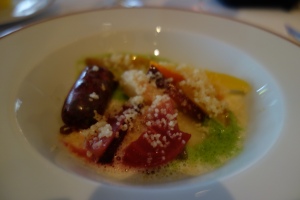 Main #5: Vegetable couscous, vegetable sausage with Argan oil (5/5)
Main #5: Vegetable couscous, vegetable sausage with Argan oil (5/5)
Jardieniere Arlequin et fin couscous a la l’huile de argan – merguez végétale à l’harissa
A sausage made of beetroot and carrot, the skin made of lamb (the only non-vegetable based ingredient on this plate). Again, highlighting the potential of vegetables. Of the highest quality.
Main #6: Smoked beetroot and celery consomme, vegetable ravioli (5/5)
A deep orange smoked consomme, another l’Arpege signature. Again, cooking of the highest order and imagination, with the best vegetables imaginable.
Main #7: Salad, walnut sauce, parmesan (5/5)
The best salad I have ever had. Sweet as if each leaf was dusted with powdery honey. Each salad is carefully hand-assembled leaf by leaf in the kitchen. (That’s why you pay so much I guess.) Tyler Cowen mentions that great food can be found in Haiti due to low labor costs, allowing labor-intensive food preparation. Here’s the flip-side of the equation – the best salad of your life at European labor costs, which is why l’Arpege puts the smackdown on any diner’s wallet.
Main #8: Roasted chicken in hay (3/5)
ecailles ou plumes – reflet de la gourmandise
Here was the big miss of the meal for me. Others have talked about Alain Passard as a master roaster. Unfortunately the chicken here was tough and tasteless. I didn’t finish this dish.
Cheese: Blue smoked potato with Moelleux du Revard [cow cheese from the Alps] (4/5)
Moelleux du Revard – pommes de terre agria fumées au vieux chêne
Great cheese (from Bernard Antony), but the smoked blue potato was a tad overcooked and starchy.
Mignardises (5/5)
Celery macaron, carrot macaron, apple tart. brown geranium teardrops. white laurel teardrops, nougat.
Sucrerie – nougat, pate de legume, chocolat, Bouquet de rose
Incredible. The Bouquet of Roses makes a sneak appearance in miniature as the apple tart; carrot macarons and brown geranium teardrops were the other highlights of the dessert tray.
Dessert: Pear and Vanilla Millefeuille (5/5)
Why do things change? Plato thought it was because the world of appearances is a degenerate plane of existence, separate from the world of abstract Forms. I am happy to report that the Platonic Form is millefeuille has deigned to visit us in our degenerate world, and it is found in l’Arpege. Everyone oohs and aahs over the l’Arpege millefeuille, because it is the best millefeuille on Earth. Incredibly flaky, buttery, light, streaked with caramel. I will remember this for a very long time.
______________________
l’Arpege deserves its reputation at the pinnacle of world restaurants. If you would like to taste the possibilities of vegetables, you must pay a visit to l’Arpege. WIth a sunny and light-kissed dining room, I found l’Arpege’s decor very warm and inviting. According to Adam Goldberg (A Life Worth Eating), lunch service and dinner service at l’Arpege are quite similar, so lunch might be a better sampler option for those who don’t want to burn 400 Euros on one meal.
I dine, partially to experience the creativity of master chefs, who devote their lives to perfecting their craft, partially to form taste-memories of the Gilded Age of cooking. It is the Golden Age of cooking; it is the Gilded Age of food. I left l’Arpege having learnt what it meant for vegetables to be grand crus.
______________________
Memory: Celerisotto, Vegetable Ravioli Consomme, Pear Millefeuille, Salt-Baked Beetroot, Cevennes Onion-Truffle Gratin
Overall Rating: 20/20
______________________
Other write-ups:

